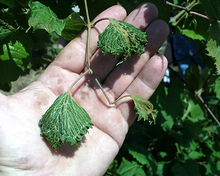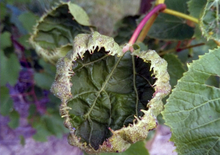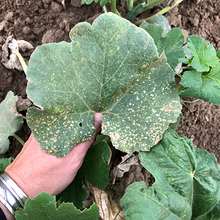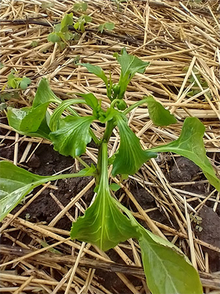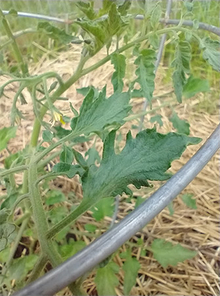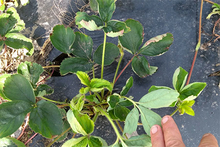Quick facts
- Fruit, vegetable and ornamental plants can be injured by drift from herbicides that are sprayed on nearby lawns and crop fields to kill weeds.
- Herbicide injury symptoms depend on the herbicide applied and the garden plant species.
- Know how to identify herbicide injury and tell it apart from other plant problems like nutrient deficiency and diseases.
- Prevent herbicide injury by reducing or eliminating lawn herbicide applications, communicating with your neighbors and only spraying under certain weather conditions.
Herbicide drift happens when herbicides move through the air in droplets or vapor during an application, causing injury to nearby sensitive plants that they land on. Many fruit, vegetable and ornamental plants are sensitive to popular lawn and crop herbicides. Drift is most likely to occur during very windy, or very still (less than 3 mph) conditions. Any herbicide is prone to drifting if applied under the wrong conditions.
Common herbicides that may drift
Some common lawn herbicides, also called “weed killers”, contain the active ingredients dicamba, 2,4-D or triclopyr. These growth regulator herbicides tend to have a low vapor pressure, or more tendency to evaporate.
Under the right conditions, they can vaporize in the hours or days after application, and move through the air. This is called volatilization. Spraying these products during or prior to hot, dry conditions increases the risk of off-target movement through volatilization.
Glyphosate, the active ingredient in Roundup®, can also injure many types of garden plants when it is applied very close to them, especially during windy weather. It is a non-selective herbicide, meaning that it can kill a wide range of plant species.
Decreasing herbicide drift in your lawn and garden
- Minimize herbicide usage and use non-chemical forms of weed control to decrease the risk of herbicide drift.
- If your neighbors spray their lawn, communicate with them about your garden and ask them to avoid spraying herbicides in windy or hot, dry conditions.
- If you plan to spray your lawn, advise your neighbors, and take care to avoid spraying near their high-value plants, or when conditions favor drift or volatilization.
- Read the label on all herbicides before applying them to your lawn or garden, and know which active ingredients they contain. Each product is different: look for instructions about when and how to apply each product safely and responsibly.
- If hiring a lawn care company, alert them about your sensitive garden plants
- Do not spray products containing growth regulator herbicides (listed above) during or prior to hot, dry, windy, or completely still conditions.
Watering the lawn after growth regulator herbicides were applied may decrease the chance of drift through volatilization, according to research by Iowa State University.
Diagnosing herbicide injury
Refer to the photos in the drawers below to help determine whether damage on your fruit crops may be due to herbicide injury. Consider whether or not herbicides were recently sprayed nearby, either in your lawn or surrounding areas.
Sometimes, herbicide injury can be confused with other issues like nutrient deficiencies or plant diseases. Use What’s Wrong With My Plant to help diagnose plant problems.
Grapevines
Grapevines are highly sensitive to 2,4-D and dicamba.
2,4-D and dicamba injury to grapevine leaves look fairly similar. They cause new leaves to be deformed, stunted and have severely serrated leaf margins. Dicamba also causes the leaves to curl inward, as the middle of the leaf blade grows faster than the edges.
Large amounts of 2,4-D or dicamba drift can gradually kill or partially kill the grapevines. While a small amount of drift stunts leaf and shoot growth, the vine can typically recover from it. Some varieties of grapes seem to be more sensitive to herbicide drift than others, but more research is needed in order to identify these varieties.
Raspberries
2,4-D and dicamba cause raspberry leaves to curl, twist and wilt. However, raspberries appear to be less susceptible to 2,4-D than dicamba and can recover within days or weeks after injury.
Vegetables
Dicamba and 2,4-D drift injury on vegetable plants causes leaf distortion, stunting and in severe cases may lead to plant death.
- Vegetables that are most sensitive to growth regulator herbicides include: Peppers, tomatoes, eggplant and beans.
- Moderately sensitive vegetables include: melons, cucumbers, summer squash and sweet potatoes.
- Some of the less sensitive species include: Basil, pumpkin, lettuce and cole crops (i.e. kale, broccoli, cauliflower, cabbage).
Sensitive plants do not always die from 2,4-D or dicamba drift. These plants may exhibit stress for several weeks after the drift occurred, before growing normally again.
2,4-D injury on the pepper and tomato plants, appeared 1-2 weeks after a lawn herbicide application on a neighboring property. The affected plants were stunted and took several weeks to begin growing normally again.
Raspberries and strawberries
Injury caused by glyphosate (the active ingredient in Roundup®) appears as yellow or white discoloration between the veins of the leaves. Often, the symptoms are more severe on the outer edges of the leaves, moving inward.
Strawberry and raspberry plants usually recover from small amounts of glyphosate drift.
Symptoms can appear on new spring growth from herbicide drift that occurred the previous year.
Apple trees
Glyphosate drift causes existing apple leaves to turn yellow and die. New leaves that emerge after the glyphosate was sprayed may also be distorted and thin, looking like sage leaves. This can even happen in the year after the herbicide was sprayed.
Problems that can be mistaken for herbicide drift
Nutrient deficiency
Nutrient deficiencies can lead to yellowish leaves that may be mistaken for herbicide damage.
- Nitrogen deficiencies result in the yellowing of the oldest plant leaves, and potassium deficiencies result in yellowing along the leaf margins.
- If a nutrient deficiency is the issue, symptoms would likely be evenly spread throughout the area, affecting nearby plants similarly.
- By taking regular soil tests and applying nutrients as needed, you can avoid deficiency problems.
Insect damage
Feeding damage from certain insects could be mistaken for herbicide injury.
- For example, squash bugs leave small yellowish-brown dots on the leaves of cucurbit plants like squash and cucumbers. Mild injury from a contact herbicide like glyphosate can look similar to this.
- Spider mites also leave yellowish-brown flecks on leaves that might be mistaken for glyphosate.
- In all cases, make sure to inspect your plants thoroughly. If insects are present, you should be able to find them by looking closely and investigating all parts of the plant, including underneath the leaves.
Viruses
Mosaic viruses, such as squash mosaic virus and cucumber mosaic virus, cause uneven discoloration or “mottling” on the leaves that could be mistaken for injury from growth regulator herbicides. If you see these symptoms, submit a sample to the Plant Disease Clinic for diagnosis.
Winter injury on apples
Often when apple trees experience winter injury, they will still produce leaves before those leaves wilt and die at some point during the season. This wilting may be mistaken for herbicide injury.
Cane diseases on fruit trees and shrubs
- Cane and spur blight diseases on raspberry kill the leaves and parts of the primocanes and floricanes. The brown, dead appearance can be mistaken for glyphosate injury.
- Fireblight kills shoots, stems, and leaves of a variety of woody garden plant species, which can be mistaken for glyphosate injury.
Wasacz, Maggie and Thierry Besancon. Specialty Crops Injury Caused by Dicamba Herbicide Drift. Plant and Pest Advisory. Rutgers Cooperative Extension. May 30, 2020.
Reviewed in 2021


